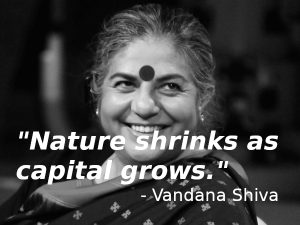I’m having an ongoing conversation with a friend about the merits and drawbacks of degrowth as a climate action strategy. She is easily the most astute climate thinker I know, with insights available only to those deeply immersed in the nuances of climate finance and decarbonization. She’s wary of the degrowth movement, as are many prominent players in the climate transition. She views it as an unhelpful distraction from humanity’s efforts to grapple with the climate crisis.
My friend’s problem lies more with degrowth as an action plan on climate than it does with degrowth’s theoretical underpinnings. Degrowth runs perpendicular to the current, hard-won momentum of the global climate response. It critiques the only consensus solution available today: the decarbonization of the global economy through a “green growth” renewable energy revolution. For green growthers, degrowth is an impractical diversion. It’s like an annoying heckler best relegated to the sidelines of climate strategy.
Degrowth’s foundational opposition to continued economic expansion presents a clear challenge to coalition-building on climate. But degrowth is grounded in the ecological reality that resources are finite, a key truth that mainstream climate advocates seem to ignore. Integration of this and other ecological insights into climate dialogue and action is crucial for shifting the needle toward a more holistic, structural response to emerging environmental collapse. Here I make the case for degrowth and green growth as crisis response strategies, then explore the potential for a productive interlocution between the two.
A Case for Degrowth
The degrowth movement embraces the inconvenient truth that climate change is only one of several macro-scale challenges unfolding on the planet today. The most striking examples are today’s rapidly advancing ecological overshoot, whereby renewable resources are used faster than they are regenerated by nature, along with the sixth mass extinction. Existential crises like these are the direct result of human economic activity.
Today, humans and their livestock account for 96% of mammalian biomass, and wild animals make up only 4%. Half of the earth’s habitable land has been converted to agricultural use. We use more water, forests, soil, and other biological resources than the earth can naturally replenish, creating scarcity for future generations of humans, not to mention our fellow species. These concerns extend well beyond carbon emissions and require aggressive action in step with initiatives to address the climate crisis.
Today’s global polycrises are fundamentally intertwined, which means that we would be unwise to prioritize decarbonization over the restoration of ecological integrity, or vice versa. A whole-systems approach like degrowth recognizes the need to overhaul simultaneously our carbon-intensive energy infrastructure and the materials-intensive consumer economy it supports. Degrowth calls for structural reforms that decarbonize the economy and decrease its material intensity, while bolstering human wellbeing and democracy.
Green Growth: A Temporary Assist?
In contrast to the comprehensive ecological vision of degrowth, green growth’s scope of action is environmentally narrow. Green growth is an economic strategy as well as a political slogan whose very name demonstrates an obliviousness to the causal relationship between economic growth and environmental destruction. It heralds a sort of promised land in which humanity overcomes climate change through aggressive adoption of low-carbon energy technologies, creating enormous wealth along the way.
It is a rhetorical narrative that connotes profitable, market-based decarbonization and minimal institutional disruption. Crucially, green growth punts on issues of ecological overshoot and global resource inequity, with decarbonization as the only approach to protecting the environment. Green growth advocates treat any ecological side effects of green-growth policies, whether positive or negative, as secondary or incidental.
To give them their due, economic and political actors have used the widespread appeal of green growth to mobilize markets and governments worldwide toward the IPCC’s goal of net-zero emissions by 2050. Despite their flaws, capitalism and democracy are powerful tools for collective action, and green growth engages these institutions at the level of their key interests: profit and popularity. It’s hard to imagine where climate action would be without the use of these important levers.
An Argument for Green Growth
Another strength of green growth is its presumed ease of implementation. Whatever view we hold of the value of capital-backed tech solutions, most people view them as more feasible in the short term than large-scale behavior change or structural reform. Bill McKibben, once an outspoken proponent of a growth-critical climate response, recently made a tactical shift on this question on The Ezra Klein Show:
“The physics of climate change enforces a certain brute reality in one’s set of solutions. And the timing question is the single biggest enforcer of that reality. We have to make very, very rapid change. And so changes in basic human desires or even changes in the physical setup of our world around us come, if they come at all, more slowly.
I think in 100 years, it’s unlikely human beings will be amusing themselves by consuming immense amounts of stuff. I think we’re likely to have moved beyond that. But in seven years, I doubt it. I think for the moment, we’re stuck with things like the suburb, where I grew up, and the physical limits that it enforces on us, which means lots of people driving cars. So we better figure out how to make electric cars work, at least for now. And we better do it very quickly…”
This conversation helped me, begrudgingly, to view green growth as a vehicle that can help us outpace the disaster nipping at our heels. But several factors prevent me from a wholesale embrace of green growth.
The Limits to (Green) Growth
First, it is very unclear whether green growth can actually deliver all the climate progress it promises, given the rising energy demands built into growth. In 2018, the IPCC released a report modeling pathways to net-zero “under a range of assumptions about economic growth, technology development and lifestyles.” Pathways to net-zero that assumed business-as-usual economic growth rely heavily on carbon dioxide removal (CDR), of which the IPCC had this to say:
“CDR deployed at scale is unproven, and reliance on such technology is a major risk in the ability to limit warming to 1.5 degrees Celsius. CDR is needed less in pathways with particularly strong emphasis on energy efficiency and low demand.”
In other words, a key tool in the green growth toolbox is yet to be verified as effective.
Beyond the unknown effectiveness of CDR schemes are its side effects. One type of CDR, known as BECCS, for “bio-energy with carbon capture and storage,” could involve converting massive amounts of land to monoculture tree plantations. It is projected to result in a 10% loss in global forest cover and 7% loss in biodiversity. Just what we need!
Furthermore, in relying so heavily on the market, green growth situates opaque financial entities like BlackRock and other asset-management firms at the vanguard of the climate response. These companies are patently more concerned with short-term profits than with climate-change mitigation. Aside from a naive faith that the invisible hand of the market will lead to an optimal allocation of resources, what makes us think these titans of capitalist finance are willing to play by the rules? Finally, the zeitgeist of green growth undermines and ignores the potential for structural reforms to advance decarbonization. It is too mired in ideology to act in our best interests and attack climate change from all available angles.
With a generous vision, one can see how green growth might allow us to innovate our way out of the climate crisis, if kept on a tight leash. Green growthers argue that, once we’ve decarbonized, we can turn our attention to other ecological and social crises. But even in a best-case scenario, the resource demands of green growth will undoubtedly exacerbate environmental destruction and social inequality. Even if green growth could proceed without sacrificing ever more ecological integrity, the emerging collapse of planetary systems requires our intervention now, not in thirty years.
Where Do We Go from Here?
Herman Daly, the father of steady state economics, emphasized that steady-state policies should be politically salient within “historically-given initial conditions.” Our initial conditions are clear: The international community has essentially agreed to pursue, as its primary climate strategy, market-based decarbonization through investment in “green” technologies. This strategy would use as little structural reform as possible. In other words, we plan to curb emissions without curbing economic activity.
Given this tricky starting point, how might degrowth toward a steady state economy proceed? First, we need to recognize that degrowthers and green growthers are invested in the same outcome: a viable future for life on earth. We have different timelines and priorities, but we are all on the same team—and we can’t afford to proceed without dialogue and coordination. We need each other.
Moreover, we can look for the considerable areas of mutualism that exist between the two strategies. For example, 40% of all shipping traffic consists of transporting fossil fuels. A global switch to renewable energy across all economic sectors, from power generation to transportation, would eliminate almost all of that 40%, effectively de-growing the shipping sector. There are also, obviously, many decarbonization gains built into degrowth reforms.
It is therefore not unthinkable that a brief period of “green-growth decarbonization” could still serve as the beginning of a larger degrowth transformation toward a freer, more relational future. In this speculative article, Patrick Loftus envisions a degrowth transition that begins slowly, with market-based, green-growth strategies building out a foundation of low-carbon technologies. We would utilize these to support increasingly regenerative, no-growth communities as the crisis deepens and the limits to growth become more visibly and violently clear.
A Suggestion
I suggest that degrowth thought leaders shift at least in part from evangelizing a birds-eye, long-term view of degrowth and the steady-state future to identifying degrowth opportunities available within the given institutional framework. This approach would bring about incremental but substantial degrowth, providing proof of concept and laying the foundation for a larger transformation away from consumerism and growth dependence.
We should pick the low-hanging fruits first, those with high decarbonization potential and relatively low implementation barriers. One example has to do with the rollout of electric vehicles. As Bill McKibben argues, we need to invest aggressively in electric vehicle technology and make fossil-fuel transportation a thing of the past.
At the same time, replacing the global vehicle fleet with electric vehicles on a 1:1 basis is unrealistic, unnecessary, and even imperialist. Consider, for example, the amount of lithium that would have to be mined throughout the global south to enable this “renewables-based re-boot” of western hyper-consumerism. A recent report from the Climate and Community Project offered this vital insight:
“As societies undertake the urgent and transformative task of building new, zero-emissions energy systems, some level of mining is necessary. But the volume of extraction is not a given. Neither is where mining takes place, who bears the social and environmental burdens, or how mining is governed.”
The authors outline several policies for achieving net-zero transportation emissions while minimizing environmental harm and fostering collective wellbeing, all while effectively de-growing the personal transportation sector. They advocate for an expansion of public transportation infrastructure—trains, buses, subways—to greatly reduce car dependency and, therefore, the amount of mining required to decarbonize. For example, expanding the American passenger train network to rival that of Europe would greatly reduce the emissions and material intensity associated with car and airplane travel. Such an intervention could result in degrowth at large and set a precedent for integrating structural reform into the mainstream climate response.
Incremental change can be tough to accept when you’re trying to prevent mass suffering and extinction, but as Herman Daly and Joshua Farley remind us, we must start “from where we are, even if the basic idea is not to remain there.”
This article first appeared in the Steady State Herald







10 Comments
Great article.
There is no ‘global climate response’, unless you count 27 years of COP meetings followed by record global carbon emissions as a ‘response’.
Seeing the GDP growth problem as a distraction from the main issues is like being on the Titanic and seeing the iceberg as a distraction from the main issues.
It’s not a distraction, it’s the fundamental cause of biodiversity loss and climate change. It baffles me that this isn’t obvious. What would be the state of play with climate change and biodiversity loss now, if global GDP was, say, 5% of what it actually is?
‘Green growth’ is an oxymoron – it’s impossible to dematerialise GDP growth, because:
• GDP growth means an increase in overall spending power, otherwise the increase in output can’t be purchased (and what would GDP growth actually mean if there were no corresponding increase in spending power?).
• Once overall spending power has increased, there’s no mechanism to ring-fence it so that it’s only spent on immaterial things.
• So, countries with bigger per capita GDP use more material resources per person, because they fly more, have more cars, clothes, food, furniture, electrical goods etc.
• And you can’t increase material resource use without increasing damage to the biosphere.
Capitalism has to grow forever, and therefore there is no climate solution within capitalism. Defenders of growth are in fact defenders of capitalism. It’s ideological, which means that reasoned argument is going to be very difficult.
(I’m not laying blame here either. If a pro-capitalist was given the task of persuading me that capitalist growth was beneficial or even possible on a finite planet, they’d find it very hard. People don’t change their fundamental narratives easily). I think in the end, we need to start building new ‘commons’ infrastructure (https://www.lowimpact.org/categories/commoning/further-info/building-the-commons-economy) that a) doesn’t require perpetual growth and b) provides the essentials of life affordably. Once we do that, we don’t have to persuade any more (Socratically or otherwise). People will come to us.
Why no mention of Doughnut Economics? Seems like you are in danger of reinventing a wheel that already has a solution. https://doughnuteconomics.org
Nigel – this debate has been around for a long time – way before Doughnut Economics, which doesn’t come down on either side of the ‘zero-growth (degrowth in wealthy countries) or green growth. https://steadystate.org/a-doughnut-economy-please-but-hold-the-agnostic-frosting/
It’s a great article. It succinctly sets out and critiques the two current and predominant strategies, and so in its own right it contributes to change – I found it very useful. I agree with Dave that GDP growth has to be tackled but very significant culture change needs to occur across pretty much the whole of society for this to happen. The benefit of Green Growth, as Rosalie points out, is that it seeds this culture change, providing a framework and context within which de-growth (and a better phrase needs to be found!) can be socialised. The world simply isn’t ready for a debate on de-growth, let alone it’s implementation. I think the only reason there’s a strong debate and increasing delivery of decarbonisation is that we have solutions to draw upon. Are de-growth and steady state economics mature enough to implement? I think they will rapidly grow and find traction as Green Growth changes peoples’ opinions towards a hopeful outcome. I appreciate time is short and I hope the transition through these strategies is rapid, but for me de-growth is still some years off.
Hi Phil
Yes, I think you’re right that it’s going to take time to even get the growth argument addressed by those with the power to do anything about it – which is why I lean towards the ‘doomer’ perspective. I don’t think we’re going to address the real causes of the destruction of the biosphere in time to prevent some kind of collapse scenario (‘biological annihilation’ is what the establishment / conservative ‘Proceedings of the National Academy of Sciences of the US’ call it).
Record global carbon emissions in 2022, and still rising (‘increasing delivery of decarbonisation’) isn’t happening, as far as I can see, Phil. And that’s after 27 years of COP meetings. States aren’t going to solve this problem, precisely because they’re chasing perpetual GDP growth, which undermines everything else they do (which isn’t much).
I don’t think there’s anything to ‘implement’ when it comes to stabilising the economy so that it respects natural limits – not within a capitalist global economy that has a growth imperative.
This isn’t defeatism though. A new, commons economy can be built (without the need to deliver returns to shareholders or interest to banks – the drivers of growth). Has to be built, in fact. The new commons ideas that are emerging (and that we’re promoting more and more on Lowimpact) have the potential to bring about revolutionary change (i.e. delivering a new system, not reforming this one), because, if successful, they will provide more affordable housing, energy, water, broadband, food etc. to the mainstream, requiring only self-interest rather than altruism – which is key, I think.
The fear for me with ‘green growth’ is that rather than priming people for stabilisation, it will breed complacency. Using one of my favourite analogies – if you’re on the Titanic, and you notice that it’s going to hit the iceberg, you really have to mention it, and suggest we steer away from it, not talk about using a more sustainable fuel.
Great article.
There’s a lot I agree with.
From my perspective, what’s needed is:
See also this excellent recent 42 minute BBC radio debate, featuring Kate Raworth, on “Is growth a false god?”
https://www.bbc.co.uk/sounds/play/m001k7nq
and my LinkedIn post about it here:
https://www.linkedin.com/posts/david-calver-8974ab_moral-maze-is-growth-a-false-god-bbc-activity-7046542610139619328-3-bQ?utm_source=share&utm_medium=member_desktop
Hi David (long time!)
You mention the only problem I have with Doughnut Economics – that it’s GDP-growth ‘agnostic’. As GDP growth is the main driver of biosphere destruction, I think that’s a mistake.
Your proposed solutions were all about trying to persuade governments to do something. These are the same governments that have organised and taken part in 27 years of COP meetings, which resulted in……. record carbon emissions.
I just don’t understand the faith you (and to be fair, many others) still have that the state might step in and rescue us.
What mechanisms are you thinking of, to persuade them to adopt any of your policy ideas? I mean, I could come up with a list of policies too – but then what?
I think you and I have always had a different opinion on the depth of corporate influence on / control of / symbiotic relationship with the state.
Dave,
Yes – you and I have had many enjoyable discussions about this subject over the years (but it has been a while since the last one).
I wouldn’t quite choose the language you use when suggesting I have “faith” in governments.
Any political system is unfortunately going to suffer from weaknesses, mostly relating to some of the people who inhabit those political systems, and (as you’ve just pointed out) what some describe as “capture” of political agendas by those with vested financial interests (individuals or organisations such as corporates).
I think the jury is out on whether the various governments around the world will act sufficiently robustly to help solve AGW and other sustainability crises. On the other hand, there is broad cross-party support in many places like the UK for the country and its civil servants to steer towards global net zero by mid century. The UNFCCC CoP process is still alive, even if wounded by various failings over the years and more recently by estimates that the world might overshoot Paris 1.5C. There is some relative decoupling of GDP from material economic throughput in quite a few countries (albeit that some of that is through ‘offshoring’ manufacturing). So, some encouraging signs as well as frustrating lack of progress in other ways.
It’s a messy picture currently, but we are still early in the decarbonisation transition and there’s a long way to go yet.
I think we should bear in mind the wisdom of striking the right balance between change and stability – to transition to a sustainable future for all, but without “throwing the baby out with the bathwater” (eg doing things which might crash our economies). Otherwise, the cure could be worse than the disease.
In that light, governments and big businesses, all of whose actions have been part of the problem, still have the potential to pivot to being part of the solution. With net zero targets and plans, and statements about climate crisis from many governments and businesses, these are good signs that the general mood on this has been changing more rapidly in just the last few years than in previous decades of climate activism.
AGW deniers are turning into net zero delayists, and they’re fighting a rearguard action (“fighting retreat”) for the fossil fuel industry, which I’m confident they will ultimately lose. They can’t fight the whole of the rest of society forever. Once the mainstream “moves” they will have to bend.
For me, it’s now really about how much “overshoot” there will be above 1.5C, perhaps even 2.0C before the proverbial boulder gets pushed across the plateau and starts to roll itself down the other side of the hill, picking up speed as it goes.
We need to “keep out eyes on the prize” and it’s like paddling in rough seas – keeping eyes on the safe port, but at the same time avoiding the rocks of (on the one side) climate tipping points and (on the other side) economic and social collapse through getting some things badly wrong during the transition.
I don’t think anyone has all the answers, and I might be wrong about governments and big businesses, but I wouldn’t rule them out yet, as they have scale and resources as levers that haven’t yet been applied fully enough to moving that proverbial boulder up the hill. Whether they will put their shoulders into it and push is anybody’s guess, but it would make a big difference if they did… but if they don’t, the transition will become unstoppable without their help in any case – it’s just a question of when – keep watching out for inflection points in statistics (global peak oil, peak coal, peak GHG emissions, peak cumulative atmospheric CO2, peak population…)
David
I guess we both have our narratives (very different ones), and narratives are hard to change – they’re once-in-a-lifetime events, if they happen at all.
Currently, many more people subscribe to your narrative than mine. But I think the tide is turning, thankfully – because of 27 years of COP meetings, culminating in record carbon emissions. Any jury that failed to convict governments on that evidence would have to be blind and deaf, rather than ‘out’.
I’d go further. I’d say that by pursuing perpetual GDP growth, massively subsidising fossil fuels and flying people all around the world for less-than-useless COP meetings, governments are contributing hugely to global warming and biodiversity loss. I don’t see it as govts not being enough of a positive force, but that they’re a negative force (one of the biggest, tbh).
Really confused by anyone who sees the state as a force for good.
“governments and big businesses, all of whose actions have been part of the problem, still have the potential to pivot to being part of the solution.”
This is where we disagree 100%. Governments and big business ARE the problem.
The very best we can hope for from them is to get out of the way as we build the commons economy – and I’m not at all sure they’ll do that. I think they’ll hinder any attempt to decentralise power away from them.
Great article, and great discussion.
Thanks Dave!